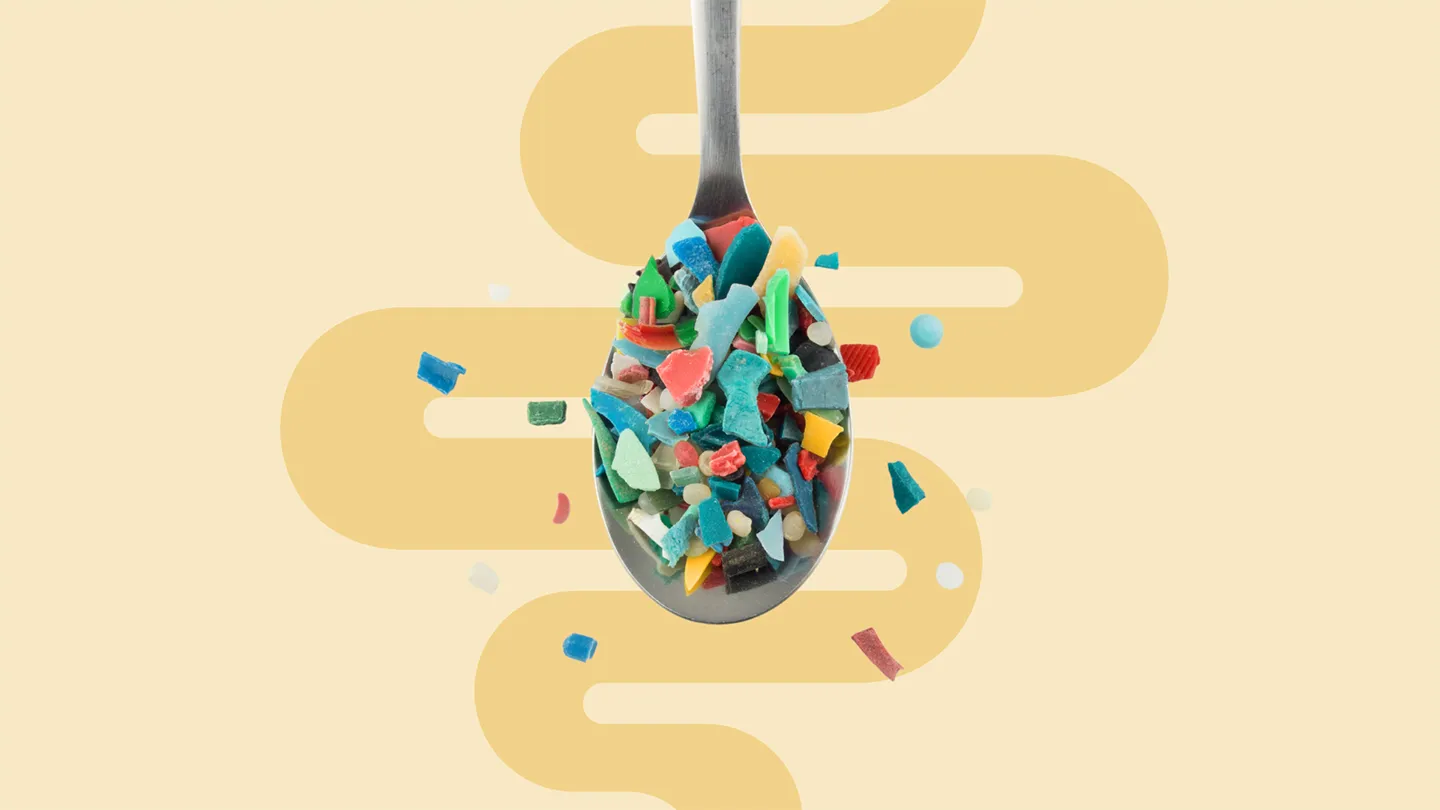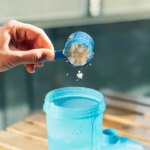There’s nothing appetizing about plastic, yet most of us consume it daily.e60dc2a1-f33c-4a05-9b50-8e3e8e59762931f42a3d-7221-4a3b-ab01-92df7a49e0a2 Microplastics — plastic debris under 5 millimeters (mm) long — are ubiquitous, found everywhere from food packaging and personal-care products to chewing gum and tap water.e60dc2a1-f33c-4a05-9b50-8e3e8e5976292e118ec0-6084-45e2-8697-ed5915045e2e They’re also abundant in the human body, including the digestive tract.e60dc2a1-f33c-4a05-9b50-8e3e8e5976291ffd0b4c-3b60-4e72-a5f6-f9ccbd785449 “Once ingested, microplastics can enter the digestive system and disrupt gut health by triggering inflammation, damaging the intestinal lining, or interfering with nutrient absorption,” says Ying Chen, PhD , a research assistant professor at Tufts University School of Engineering in Medford, Massachusetts.e60dc2a1-f33c-4a05-9b50-8e3e8e5976291ffd0b4c-3b60-4e72-a5f6-f9ccbd785449 Microplastics enter the food chain through several pathways, according to the World Economic Forum.e60dc2a1-f33c-4a05-9b50-8e3e8e597629ce444022-41a1-493f-8f94-2e017d22be51 Some types, such as microbeads used in face washes, are intentionally added to products during the manufacturing process. Others are shed from larger plastic items, such as car tires, fishing gear, and single-use food and drink containers. These small pieces of plastic can infiltrate water, soil, and air, or seep into food and beverages directly during manufacturing, storage, or cooking.e60dc2a1-f33c-4a05-9b50-8e3e8e5976295839b583-28de-4203-942f-f777efd23775 Although it’s impossible to completely avoid microplastic exposure , you can limit yours. Here are eight things to know about microplastics’ impact on gut health and how to protect yourself.
1. Microplastics Can Alter the Gut Microbiome Gut Microbiome Multiple health risks of microplastics may stem from their influence on the gut microbiome — a community of trillions of bacteria populating the digestive tract that plays a part in metabolism, appetite, sleep, mood, and immunity, among other functions.e60dc2a1-f33c-4a05-9b50-8e3e8e5976293b0a0c00-c28a-4c45-aa48-0e8b321f61f2 That’s largely because microplastics can kill beneficial bacteria in the gut, allowing harmful bacteria to flourish, Dr. Chen says.e60dc2a1-f33c-4a05-9b50-8e3e8e59762925082069-04dc-4bb0-9365-08767016d388 Known as gut dysbiosis, this phenomenon is associated with upset stomach, anxiety, depression, and digestive illnesses such as inflammatory bowel disease (IBD), among other issues.e60dc2a1-f33c-4a05-9b50-8e3e8e597629deec2bc8-ae15-41e8-a594-f43d9649832a Chen tested the effects of microplastics on lab-grown versions of gut cells that closely resemble real human intestines. “We’ve found that micro- and nano-sized plastic particles can be taken up by intestinal cells and — depending on their size and concentration — may impair gut barrier integrity and activate immune responses,” Chen says. These changes could cause long-term issues.e60dc2a1-f33c-4a05-9b50-8e3e8e59762925082069-04dc-4bb0-9365-08767016d388 In her research, Chen says she and her colleagues observed that microplastic and nanoplastic exposure also increased inflammation and weakened the gut membrane (intestinal lining).e60dc2a1-f33c-4a05-9b50-8e3e8e59762925082069-04dc-4bb0-9365-08767016d388 These factors may alter the gut microbiome and contribute to disease as well, she says.e60dc2a1-f33c-4a05-9b50-8e3e8e597629deec2bc8-ae15-41e8-a594-f43d9649832a “Although we didn’t directly test microbial shifts in the study, our findings suggest that microplastics create a stressed tissue environment that may make the gut more vulnerable to harmful microbial changes and broader health issues, including metabolic or immune-related problems,” says Chen.e60dc2a1-f33c-4a05-9b50-8e3e8e59762925082069-04dc-4bb0-9365-08767016d388
2. They May Cause a Leaky Gut Leaky Gut By irritating and weakening the gut membrane, microplastics may contribute to tears and leaks, says Andrea De Vizcaya Ruiz, PhD , a professor of environmental and occupational health at the University of California in Irvine.e60dc2a1-f33c-4a05-9b50-8e3e8e597629a8574363-12f2-4273-aae9-b03d36ff91ff “Known as ‘leaky gut,’ this allows bacteria and toxins to enter the bloodstream, triggering inflammation and introducing toxic agents, which can cause feelings of illness or fatigue,” she says.e60dc2a1-f33c-4a05-9b50-8e3e8e597629a8574363-12f2-4273-aae9-b03d36ff91ff Systemic, chronic inflammation is associated with several serious conditions, such as heart disease , metabolic disorders, diabetes , and autoimmune diseases, Dr. De Vizcaya Ruiz notes.e60dc2a1-f33c-4a05-9b50-8e3e8e597629cf990ccd-50ed-450a-9727-40cb3188e40c
3. They Can Also Affect the Liver and Pancreas Liver Issues Once microplastics in food, water, or air enter the gastrointestinal tract, they may damage the liver and pancreas, disrupting their function, says Linda Shiue, MD , the director of culinary and lifestyle medicine at Kaiser Permanente in San Francisco.e60dc2a1-f33c-4a05-9b50-8e3e8e597629c6189621-07f6-494a-96c2-193f91208597 Microplastics can carry harmful chemicals, like heavy metals and bisphenol A (BPA), on their surface, she says.e60dc2a1-f33c-4a05-9b50-8e3e8e5976292e5d4006-0b5f-40ae-b75c-636fc3cc5fc9 Organ tissue cells perceive these toxins as a threat, triggering an immune response and inflammation, which can damage cell membranes and DNA, explains Dr. Shiue.e60dc2a1-f33c-4a05-9b50-8e3e8e597629c6189621-07f6-494a-96c2-193f91208597 “In the liver, this means less ability to filter toxins or process fats. In the pancreas, this may impair insulin production, affecting blood sugar control,” she says.e60dc2a1-f33c-4a05-9b50-8e3e8e597629c6189621-07f6-494a-96c2-193f91208597 “Another way in which microplastics can cause damage is by acting as endocrine disruptors, which affects metabolism and can lead to fatty liver and insulin resistance. Fatty liver can lead to inflammation and fibrosis and even cirrhosis. Insulin resistance is a risk factor for type 2 diabetes.”e60dc2a1-f33c-4a05-9b50-8e3e8e597629b872c63c-5ba3-4a44-93cb-81a54094eeca
4. Probiotics May Help Offset Some Adverse Effects Using Probiotics Some research suggests probiotics — beneficial microorganisms that promote a balanced gut microbiome — may offset some of microplastics’ effects, says Sandhya Shukla, MD , a gastroenterologist with Atlantic Coast Gastroenterology Associates in Brick Township, New Jersey.e60dc2a1-f33c-4a05-9b50-8e3e8e597629b1f5fd42-8eb2-4e79-a18a-17668bb47b94 “Probiotics may help ameliorate the effects of microplastics on gut health by reducing inflammation, reinforcing gut barrier function, and reducing microbiota dysbiosis,” she says. “Animal model studies have shown probiotics such as Lactobacillus rhamnosus GG (LGG) alleviate oxidative stress and reduce markers of liver inflammation in mice. Similarly, Lactobacillus plantarum DP189 reduced inflammatory response in mice exposed to microplastics.”e60dc2a1-f33c-4a05-9b50-8e3e8e597629b1f5fd42-8eb2-4e79-a18a-17668bb47b94 It’s important to note that while probiotics in food are known to support digestive and overall health, research is ongoing and more studies on humans are needed before probiotic supplements or food sources are widely recommended as protection from microplastics.e60dc2a1-f33c-4a05-9b50-8e3e8e597629a63df2aa-b756-4826-a48b-c48830ed043a “While probiotics show potential in experimental settings for addressing microplastic-induced gut issues, the American Gastrointestinal Association does not currently provide any specific recommendations for their use in this context,” she adds.
5. Avoid Plastic Water Bottles Water Bottles The best way to mitigate the health risks of microplastics is to reduce your exposure, and a good way to start is to avoid plastic water bottles , says Deanna Minich, PhD , a Seattle-based nutrition scientist and the author of Whole Detox .e60dc2a1-f33c-4a05-9b50-8e3e8e597629ac4670c8-303b-4bea-bcc2-22e41438ae7a “Plastic water bottles, particularly single-use bottles made from polyethylene terephthalate (PET), can shed microplastics into the water during storage and transport, especially with temperature changes (think about plastic water bottles in cars sitting in the hot sun),” Dr. Minich says.e60dc2a1-f33c-4a05-9b50-8e3e8e597629ac4670c8-303b-4bea-bcc2-22e41438ae7a A 2024 report found that a liter of bottled water contains an average of 240,000 plastic particles.e60dc2a1-f33c-4a05-9b50-8e3e8e597629984191e5-3630-468e-ac7e-1e1b66463dfa “Switching to a reusable stainless steel or glass water bottle is a simple and effective way to reduce microplastic intake and environmental plastic pollution,” Minich says. Bear in mind that glass bottles may contain microplastics, too. A study published in 2023 analyzed the microplastic content of tap water versus bottled water from 10 popular brands. The researchers found that, while water from plastic bottles contained the highest amount of microplastics, water from glass bottles also contained more than tap water.e60dc2a1-f33c-4a05-9b50-8e3e8e597629a426ff1c-751c-44cb-8cc2-c9b42692e122
6. Filter Drinking Water Filtered Water Tap water generally doesn’t contain as many microplastics as bottled water, but it can still be contaminated, Minich says.e60dc2a1-f33c-4a05-9b50-8e3e8e5976298bdfb539-572c-4b39-a003-4caa666f5155 “Certain water filters can reduce microplastic levels, particularly those that combine activated carbon with submicron mechanical filtration, such as reverse osmosis or nanofiltration systems,” she says.e60dc2a1-f33c-4a05-9b50-8e3e8e597629828f6f71-644a-4ed1-b3ed-c60963d9e050 Activated carbon works by trapping chemicals, such as BPA, in a process called adsorption. Reverse osmosis and nanofiltration systems catch and collect tiny plastic particles while allowing water to pass.e60dc2a1-f33c-4a05-9b50-8e3e8e5976291f1200b8-7903-405b-923d-0e513ce427d0 Minich recommends choosing filters certified by the National Sanitation Foundation (NSF)/American National Standards Institute (ANSI) that specifically mention microplastic reduction.e60dc2a1-f33c-4a05-9b50-8e3e8e59762936bce59c-fe65-4a69-83b0-a363d2c74087
7. Avoid Heating Food in Plastic Reheating Food Heating plastic may cause polymers to break down and release smaller microplastics and chemical additives (such as bisphenol A and phthalates) into food and beverages, Minich says.e60dc2a1-f33c-4a05-9b50-8e3e8e597629686d22aa-e13f-4bf1-aeaa-cd80c39a70c1 “Studies show that heat significantly increases the migration of plastic particles into food, particularly fatty or acidic (such as tomato sauce) foods,” she says.e60dc2a1-f33c-4a05-9b50-8e3e8e597629686d22aa-e13f-4bf1-aeaa-cd80c39a70c1 “I recommend avoiding heating food in plastic containers whenever possible.” Choose glass, steel, or ceramic instead to heat food, Minich advises, and opt to handwash plastic in lukewarm water instead of cleaning it in a high-heat dishwasher.
8. Reduce Plastic Food Packaging Limiting Plastic Packaging Plastic food packaging can shed microplastics onto food, especially when rubbed, cut, or exposed to heat.e60dc2a1-f33c-4a05-9b50-8e3e8e5976290c0f6e93-e69f-4178-a4a5-a3c0ea94dc00 Choosing items wrapped in paper or compostable material can help reduce environmental pollution and microplastic exposure, Minich says. “Also, think about how long something has been sitting in plastic, with the potential to concentrate microplastics further,” she says.e60dc2a1-f33c-4a05-9b50-8e3e8e5976290c0f6e93-e69f-4178-a4a5-a3c0ea94dc00 “Shopping at farmers’ markets rather than mainstream grocery stores might be a better option for more than one reason — the food tends to be fresher and not sitting around in plastic wrapping for an extended time.” Additionally, it’s best to avoid storing food in plastic containers.e60dc2a1-f33c-4a05-9b50-8e3e8e5976293d5cace0-4783-41f1-80aa-69d5b82bce1f Instead, opt for metal or glass.
The Takeaway Microplastics, which are ubiquitous in the food system and environment, can have damaging effects on the body, including the gut. More research is needed to explore the connection between microplastics and gut health, but evidence so far suggests these tiny particles can disrupt the microbiome and contribute to issues like a leaky gut and systemic inflammation. Although it may be impossible to evade them completely, you can reduce your exposure to microplastics by limiting plastic use in general.
Read the full article here
Leave a comment




